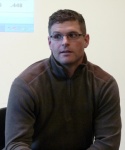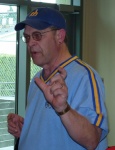Northwest Chapter meeting recap – 2/18/2012
By Mark Brunke
The Northwest Chapter of SABR held a meeting February 18, 2012 at the Multnomah County Library in the Hillsdale neighborhood in southwest Portland. The library is a block away from Wilson High School, where two-time NL MVP Dale Murphy, Wayne Twitchell, and former NBA point guard Damon Stoudamire attended.
 Our guest speaker was former Colorado Rockies catcher Ben Petrick. Ben starred at Glencoe High School in Hillsboro, about 20 miles west of Portland. He was drafted in the second round by Colorado in 1995, and progressed to the big leagues for 19 games in 1999. During that stretch, Ben hit .323 and slugged .565. He did as well in half a major league season in 2000. Ben detailed how before that season he went to the Arizona Fall League and began to notice problems with his left hand. Shortly thereafter he was diagnosed with Parkinsonism symptoms at the unusually young age of 22. His father, age 54 at the time, had been diagnosed with Parkinson’s disease only seven months earlier.
Our guest speaker was former Colorado Rockies catcher Ben Petrick. Ben starred at Glencoe High School in Hillsboro, about 20 miles west of Portland. He was drafted in the second round by Colorado in 1995, and progressed to the big leagues for 19 games in 1999. During that stretch, Ben hit .323 and slugged .565. He did as well in half a major league season in 2000. Ben detailed how before that season he went to the Arizona Fall League and began to notice problems with his left hand. Shortly thereafter he was diagnosed with Parkinsonism symptoms at the unusually young age of 22. His father, age 54 at the time, had been diagnosed with Parkinson’s disease only seven months earlier.
The Rockies did not realize that Ben had Parkinson’s disease, but it progressively hindered his playing ability. Ben’s story is compelling and his recounting was inspirational. He talked about the remainder of his baseball career and his life today. He answered many questions, including the type of support he had in baseball regarding his condition, how pitching and hitting at Coors Field is different than elsewhere, and the Buster Posey injury. Ben has a website, http://www.benpetrick.com, and a book about his life and work, Forty Thousand To One.
You may be asking yourself, “Did Ben Petrick catch more innings than Miguel Olivo for the Colorado Rockies?” The answer is yes. Petrick’s 1,246.7 innings is seventh all-time for the Rockies, while Olivo is tenth on their list. Olivo is, however, seventh all-time for the Mariners. We learned this from the presentation, “Defensive innings by position players from 1955-2011” by Dan Schlewitz. This was an extension of his meticulously researched and enlightening study of team stability and player mobility.
 Dan delivered much of his information in trivia-quiz format, as we guessed leaders for various teams. Dan presented graphs showing the top 10 players for each team at each position as a percentage of cumulative defensive innings, and gave a handout showing the top 10 players by defensive inning and position for every major league team for the period covered by the study.
Dan delivered much of his information in trivia-quiz format, as we guessed leaders for various teams. Dan presented graphs showing the top 10 players for each team at each position as a percentage of cumulative defensive innings, and gave a handout showing the top 10 players by defensive inning and position for every major league team for the period covered by the study.
Greg Rybarczyk made a presentation about his invention that measures the distance of home runs, which is now known as the ESPN Home Run Tracker. Greg described his background as a Red Sox fan and his experience in the U.S. Navy with navigation and projectile analysis and teaching physics. His inspiration for developing the Home Run Tracker came from watching video of Manny Ramirez hitting a home run over the left field lights at Fenway Park that was “officially” announced as being 451 feet, an announcement he found curiously one foot
short of Ted Williams’ 452 foot shot to the now famous red seat. Greg analyzed the flaws with the “IBM tale of the tape,” and explained his invention and the models it uses to measure home run length. He further developed his aerodynamic model.
The ESPN Home Run Tracker now has information for every home run since 2006. You can sort the information by hitter, pitcher, and ballpark; as well as see a scatter plot of each player’s home runs. Greg further demonstrated his expertise and the depth of his preparation while answering our many questions.
We briefly discussed several items of chapter business. Mark Brunke has accepted the Secretary position. A new Vice President/President-elect (preferably from Oregon) will be needed next year. Contact Rick or John with nominations or questions. We didn’t settle on a date for our spring/summer meeting in Seattle, but narrowed it to May 5 or June 16. Send your vote to Rick. Interest in a summer meeting in Oregon was inconclusive. John will poll members with options.
David Alvarez followed with a provocative proposal entitled, “Let’s Truly Realign MLB.” David’s inspiration was other realignment proposals from the past 20 years and Houston’s impending move to the AL West.
David provided a handout for the presentation and discussion. His idea is to realign teams into three leagues with no divisions. The leagues would be geographically organized with a shorter, albeit more balanced schedule of 146 games. Playoffs for eight teams in each league would begin in mid-September with a World Series ending in October. The three league champions would play each other in a round-robin tournament. David acknowledged flaws in his proposal, including its complexity, and reasons why it would not be implemented by the owners. Still, audience response was favorable.
The final presentation was Mike Rice’s eagerly anticipated annual Mariners roundtable discussion. Mike provided an overview of the Mariners roster and off-season moves and looked at some of the big issues facing the Mariners, such as producing more runs and where is Ichiro going to hit.
Mike analyzed the trade of Michael Pineda for Jesus Montero, and the possibility of Montero becoming a productive hitter. Mike and others concurred that the Mariners were hurt long-term by the two winning seasons they had in recent years.
Mike concluded by having everyone guess the Mariners win total this year. Our predictions ranged from 59 to 77. The median, 72, was pretty close to the average, 71.12 wins. We’ll see.
John Henshell concluded the meeting by awarding baseball books to members who volunteered at Mariners FanFest 2012, traveled a long way to the meeting, and correctly answered trivia questions.
For more information on the Northwest Chapter, visit http://chapters.sabr.org/nwsabr.


